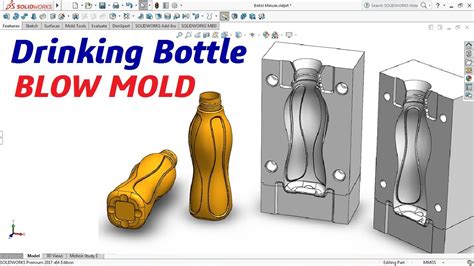How To Make A Blow Mold
Ronan Farrow
Apr 01, 2025 · 3 min read

Table of Contents
How to Make a Blow Mold: A Comprehensive Guide
Creating a blow mold might seem like a complex process, but with the right knowledge and tools, it's achievable. This guide will walk you through the steps, explaining the techniques and considerations involved in making your own blow mold.
Understanding the Blow Molding Process
Blow molding is a manufacturing process used to create hollow plastic parts. It involves inflating a heated plastic tube inside a closed mold. The heated plastic conforms to the shape of the mold, cooling and solidifying to form the final product. This process is commonly used to create a wide variety of items, from bottles and containers to toys and automotive parts. While industrial blow molding requires specialized, expensive machinery, smaller-scale versions can be attempted with ingenuity and the right approach.
Key Materials and Tools (for a simplified approach)
While true industrial-scale blow molding is beyond the scope of a home project, you can explore simplified versions using readily available materials:
- Thermoplastic Material: Low-density polyethylene (LDPE) is a good starting point for its flexibility and relative ease of melting. You could potentially source this from recycled plastic bags (though purity is crucial). Caution: Recycling plastic at home can be dangerous; be very careful and aware of the potential dangers before proceeding.
- Heat Source: A heat gun is a suitable option for smaller-scale experiments. A propane torch is not recommended due to uneven heat distribution and safety risks.
- Mold: Creating the mold is the most challenging aspect. You'll need a durable, heat-resistant material like metal (aluminum is a good choice) or a very sturdy, heat-resistant plastic. The mold needs to be precisely crafted to ensure the desired shape. Consider using a two-part mold for easier removal of the finished product.
- Air Source: A bicycle pump or a small air compressor can provide the necessary air pressure to inflate the plastic tube.
Step-by-Step Guide (Simplified Approach)
This simplified method focuses on the fundamental principles of blow molding rather than replicating industrial precision. It is important to prioritize safety and manage expectations regarding the final product's quality.
-
Prepare the Plastic: Cut the thermoplastic material into a manageable size and shape. The exact dimensions depend on the mold you've designed.
-
Heat the Plastic: Carefully use the heat gun to heat the plastic until it becomes soft and pliable. It is crucial to achieve even heating to prevent uneven thickness and defects in the finished product.
-
Form the Parison: While the plastic is still malleable, gently shape it into a tube-like structure (called a parison). This will be the basis for your blow mold.
-
Place in the Mold: Quickly insert the heated parison into one half of your mold. Close the mold halves securely.
-
Inflate the Parison: Introduce air pressure using your air source. Carefully inflate the parison until it fully fills the mold cavity.
-
Cool and Solidify: Allow the inflated plastic to cool and solidify within the mold. This may take several minutes.
-
Remove the Blow Mold: Once cool, carefully open the mold and remove your blow-molded piece.
Challenges and Considerations
This simplified approach will likely result in blow molds with imperfections. Uneven thickness, air pockets, and imperfect shaping are common challenges. Experimentation is key to improving your results. The quality of the mold itself significantly impacts the final product.
Safety First: Working with heated plastics and compressed air requires caution. Always wear appropriate safety gear, including gloves and eye protection.
Conclusion
Making a blow mold at home is a challenging but rewarding project. While achieving professional results requires industrial equipment, a simplified approach allows you to explore the fundamental principles and gain valuable hands-on experience. Remember to prioritize safety and manage your expectations, focusing on the learning experience rather than perfection.
Featured Posts
Also read the following articles
| Article Title | Date |
|---|---|
| How To Paint Vog Walls | Apr 01, 2025 |
| How To Make Cushion Covers For Outdoor Furniture | Apr 01, 2025 |
| How To Level The Ground For A Swing Set | Apr 01, 2025 |
| How To Keep Birds Off Boat | Apr 01, 2025 |
| How To Pray New Muslim Convert | Apr 01, 2025 |
Latest Posts
-
Hip Or Back Pain How To Tell
Apr 03, 2025
-
High Climax Cbd How To Use
Apr 03, 2025
-
Hi Pro Pac Keratin Protein No Frizz Hair How To Use
Apr 03, 2025
-
Heres How Mixed Drinks
Apr 03, 2025
-
Henry Howe Grand Forks Nd
Apr 03, 2025
Thank you for visiting our website which covers about How To Make A Blow Mold . We hope the information provided has been useful to you. Feel free to contact us if you have any questions or need further assistance. See you next time and don't miss to bookmark.
